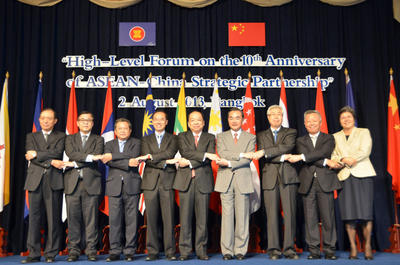Although Asian economies are more and more co-dependent security relations remain fractious. Anti-social nationalism is bubbling to the surface in many Asia Pacific nations, as Southeast Asian nations protest against perceived Chinese expansionism, hate groups emerge in Japan, and extreme refugee policy becomes the norm in Australia.
The solution to the Asia Pacific’s security woes is further integration and a stronger sense of regional rather than strictly national interests. Asia also needs a platform upon which it can resolve regional issues multilaterally. ASEAN stands out as the best staging ground for this project. Its well-established culture of consensus acts to prevent dominant powers like the United States and China leveraging their strategic positions to get their own way, as all participants effectively have veto power.
ASEAN’s emphasis on multilateral summits is also useful in this regard. In bilateral negotiations, China and the United States can strongarm smaller states. But at large multilateral diplomatic summits like the East Asia Summit and the ASEAN Regional Forum, small and middle powers can act as a block to counter the stronger bargaining position of major powers. The frequency of multilateral summits also serves to enshrine regional rather than national interests.
The major powers understand that they are less effective in exerting their will if they have to negotiate simultaneously with many parties. That is one reason why China insists on resolving disputes over the South China Sea bilaterally. China has also increased its financial involvement in some ASEAN nations to gain bilateral leverage. Cambodia is a notable case. Chinese cumulative investment in Cambodia from 1994–2012 amounted to $9.17 billion, with an additional $2.17 billion in ‘no strings attached’ aid. In this context, ASEAN’s inability to issue a joint communiqué under Cambodia’s chairmanship in 2012 as a result of disagreement over South China Sea territorial issues could be considered the result of Chinese meddling.
The United States is also pursuing bilateral diplomacy to strengthen its position within the ASEAN+ framework. It responds vigorously to any jitters on the part of small Southeast Asian nations to Chinese activity by docking warships in regional harbours as they become available. It has also moved to improve its relationship with non-ASEAN Asian nations. It has sold fighter jets to Taiwan, stationed marines in the north of Australia, engaged in several rounds of joint naval exercises with India, and it continues to station troops in Japan
ASEAN and the middle powers of the Asia Pacific must be wary of these attempts by the major powers to polarise the region and act as a unified block as much as possible. At present, ASEAN can resist the machinations of the region’s major powers, but it cannot exert pressure on them. In so far as ASEAN nations are able to assess their national interest through the lens of regional interest, with a unified approach to the South China Sea territorial disputes, for example, they could turn ASEAN into a much more powerful force. It could then bring the major powers more effectively into the association’s orbit and push for policies with region-wide advantages.
ASEAN’s Regional Comprehensive Economic Partnership (RCEP) is a good example of such unified policy making, and a possible template for future endeavours. Unlike America’s trans-pacific partnership, membership of RCEP is not conditional on accepting regionally divisive, non-trade terms. These terms include overly strict intellectual property protections and controls on state ownership of industry. The former is irksome to India, while the latter effectively excludes China from the agreement. RCEP is more modest than the TPP, essentially proposing to combine the region’s existing free trade agreements, which would improve the trade environment for everyone.
Alongside such economic endeavours, the Asia Pacific region must build a strategic community. Middle powers will be crucial to this process, but many of them will need to neuter racial and nationalist sentiment in order to contribute. Australia, for example, must resolve its poisonous refugee policy conundrum so that its diplomatic missions to neighbours like Malaysia and Indonesia can be deployed to discuss larger regional issues. Abe needs to double down on his progress revitalising Japan’s economy rather than spending time on pet nationalist projects, like getting rid of article 9, the pacifist clause of the Japanese constitution.
Other nations, particularly those of ASEAN, will need to ensure sound economic management so their growth is not dependent on assistance from foreign states, so that populist nationalist policies relating to strategic interests don’t distract the public from economic matters.
ASEAN is dependent on trade for growth, and trade depends on a stable security environment. The Association’s diplomatic traditions are underpinned by this incentive for cooperation, which makes it a powerful mechanism for security and economic prosperity. Middle powers can lend their strength to this mechanism so it can act as a magnifier for regional interests and resist great power attempts at accidental or purposeful hegemony. The energy of the great powers will then be better harnessed to drive further development across all of Asia.
Mark Fabian is a postgraduate student at the Australian National University.


You are wrong when you think “Southeast Asian nations protest against perceived Chinese expansionism”. By now, there are enough Chinese criminal and lawless acts for these nations to know it’s not perception but reality.You are wrong when you think only Japan “works on its nationalist projects” or Asean nations foster “populist nationalist policies relating to strategic interests” while neglecting economic independence. What’s the common denominator of all current Asian tensions? China! And if you failed to see the their populist nationalist policies and aggressive acts, I would suggest you look at Xi’s Chinese Dream again. Asean institutional structure can drag along a RCEP but can’t support a united stand against any external security threat, especially if that threat is China.